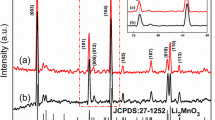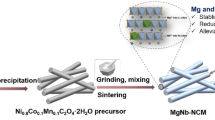Abstract
Ni-rich binary cathode materials have attracted much attention due to their high specific capacity, good performance-cost ratio, and environmental friendliness. However, their commercial application is limited by the problems of rapid capacity attenuation and poor cycling performance at high voltage. In this work, Zr and conductive ks-6 co-modified LiNi0.85Mn0.15O2 cathode materials are successfully synthesized through optimizing the proportion of modified components. The results show that the discharge capacity of LiNi0.85Mn0.15O2 co-modified with Zr and 2 wt% ks-6 (NMZ-2) increases from 182.71 mAh g−1 to 203.32 mAh g−1, and the capacity retention rate rises from 67.59 to 81.09% after 100 cycles at 1 C between 2.75 V and 4.35 V. The excellent Li-storage performance may be attributed to the synergistic effect of conductive ks-6 and Zr doping, which not only increases the electronic conductivity and reduces the electrode polarization, but also significantly reduces the cation mixing and inhibits the irreversible phase transition during cycling. The co-modified LiNi0.85Mn0.15O2 cathode material shows higher Ni3+ content and layer structure integrity, which enhance the reversibility and cycling stability of the electrode during cycling.








Similar content being viewed by others
References
Ding Y, Mu DB, Wu BR et al (2017) Recent progresses on nickel-rich layered oxide positive electrode materials used in lithium-ion batteries for electric vehicles. Appl Energy 195:586–599
Xu J, Ma J, Fan Q et al (2017) Recent progress in the design of advanced cathode materials and battery models for high-performance lithium-x (x = O2, S, Se, Te, I2, Br 2) batteries. Adv Mater 29:1606454
Wu Z, Wang Y, Liu X et al (2019) Carbon-nanomaterial-based flexible batteries for wearable elecctronics. Adv Mater 31:1800716
Han Y, Wang W, Zou J et al (2020) Self-powered energy conversion and energy storage system based on triboelectric nanogenerator. Nano Energy 76:105008
Li F, He J, Liu J et al (2021) Gradient solid electrolyte interphase and lithium-ion solvation regulated by bisfluoroacetamide for stable lithium metal batteries. Angew Chem Int Ed 60:6600–6608
Qi S, Wang H, He J et al (2021) Electrolytes enriched by potassium perfluorinated sulfonates for lithium metal batteries. Sci Bull 66:685–693
Wood M, Li JL, Ruther RE et al (2020) Chemical stability and long-term cell performance of low-cobalt, Ni-rich cathodes prepared by aqueous processing for high-energy Li-ion batteries. Energy Storage Mater 24:188–197
Liu W, Cheng X, Wang C et al (2021) Enhancing high cycle stability of Ni-rich LiNi0.94Co0.04Al0.02O2 layered cathode material. Ionics 27:1–10
Li TX, Li DL, Zhang QB et al (2021) Preparation and electrochemical performance of macroporous Ni-rich LiNi0.8Co0.1Mn0.1O2 cathode material. Acta Chim Sinica 79:678–684
Du ML, Yang P, He WX et al (2019) Enhanced high-voltage cycling stability of Ni-rich LiNi0.8Co0.1Mn0.1O2 cathode coated with Li2O-2B2O3. J Alloys Compd 805:991–998
Feng Z, Rajagopalan R, Sun D et al (2020) In-situ formation of hybrid Li3PO4-AlPO4-Al(PO3)3 coating layer on LiNi0.8Co0.1Mn0.1O2 cathode with enhanced electrochemical properties for lithium-ion battery. Chem Eng J 382:122959
Li XL, Jin LB, Song DW et al (2020) LiNbO3-coated LiNi0.8Co0.1Mn0.1O2 cathode with high discharge capacity and rate performance for all-solid-state lithium battery. J Energy Chem 40:39–45
Song Z, Cao X, Cui C et al (2021) Improved preparation efficiency and electrochemical performance of LiNi0.8Co0.15Al0.05O2 cathode material by oxalic acid and freeze-drying. Ionics 27:1–10
Xie ZC, Zhang YY, Yuan AB et al (2019) Effects of lithium excess and SnO2 surface coating on the electrochemical performance of LiNi0.8Co0.15Al0.05O2 cathode material for Li-ion batteries. J Alloys Compd 787:429–439
Liang M, Sun YM, Song DW et al (2019) Superior electrochemical performance of quasi-concentration-gradient LiNi0.8Co0.15Al0.05O2 cathode material synthesized with multi-shell precursor and new aluminum source. Electrochim Acta 300:426–436
Leng J, Wang J, Peng W et al (2021) Highly-dispersed submicrometer single-crystal nickel-rich layered cathode: spray synthesis and accelerated lithium-ion transport. Small 17:2006869
Wang R, Wang J, Chen S et al (2020) Effectively stabilizing electrode/electrolyte interface of high-energy LiNi0.9Co0.1O2//Si–C system by simple cathode surface-coating. Nano Energy 76:105065
Chen X, Tang Y, Fan CL et al (2020) A highly stabilized single crystalline nickel-rich LiNi0.8Co0.1Mn0.1O2 cathode through a novel surface spinel-phase modification. Electrochim Acta 341:136075
Mo WB, Wang ZX, Wang JX et al (2020) Tuning the surface of LiNi0.8Co0.1Mn0.1O2 primary particle with lithium boron oxide toward stable cycling. Chem Eng J 400:125820
Zhao SS, Shao L, Li X et al (2020) Acid-corrosion-formed amorphous phosphate surfaces improve electrochemical stability of LiNi0.8Co0.15Al0.05O2 cathodes. Corros Sci 168:108553
Wu LP, Tang XC, Rong ZH et al (2019) Studies on electrochemical reversibility of lithium tungstate coated Ni-rich LiNi0.8Co0.1Mn0.1O2 cathode material under high cut-off voltage cycling. Appl Surf Sci 484:21–32
Hu GR, Qi XY, Hu KH et al (2018) A facile cathode design with a LiNi0.6Co0.2Mn0.2O2 core and an AlF3-activated Li1.2Ni0.2Mn0.6O2 shell for Li-ion batteries. Electrochim Acta 265:391–399
Baster D, Paziak P, Ziąbka M et al (2018) LiNi0.6Co0.4-zTizO2-new cathode materials for Li-ion batteries. Solid State Ionics 320:118–125
Liu Y, Yao WL, Lei C et al (2020) Li2TiO3 and Li2ZrO3 co-modification LiNi0.8Co0.1Mn0.1O2 cathode material with improved high-voltage cycling performance for lithium-ion batteries. Solid State Ionics 349:115292
Zhao B, Si J, Cao CH et al (2019) Enhanced electrochemical performance of LiNi0.8Co0.15Al0.05O2 cathode by reducing lithium residue with low-temperature fluorination treatment. Solid State Ionics 339:114998
Huang J, Liu J, He J et al (2021) Optimizing electrode/electrolyte interphases and Li-ion flux/solvation for lithium-metal batteries with qua-functional heptafluorobutyric anhydride. Angew Chem Int Ed 60:20717–20722
Liu S, Dang Z, Liu D et al (2018) Comparative studies of zirconium doping and coating on LiNi0.6Co0.2Mn0.2O2 cathode material at elevated temperatures. J Power Sources 396:288–296
Song L, Li X, Xiao Z et al (2019) Effect of Zr doping and Li2O-2B2O3 layer on the structural electrochemical properties of LiNi0.5Co0.2Mn0.3O2 cathode material: experiments and first-principle calculations. Ionics 25:2017–2026
Song X, Liu G, Yue H et al (2021) A novel low-cobalt long-life LiNi0.88Co0.06Mn0.03Al0.03O2 cathode material for lithium ion batteries. Chem Eng J 407:126301
Yao L, Li Y, Gao X et al (2021) Microstructure boosting the cycling stability of LiNi0.6Co0.2Mn0.2O2 cathode through Zr-based dual modification. Energy Storage Mater 36:179–185
Jung CH, Li Q, Kim DH et al (2021) Revisiting the role of Zr doping in Ni-rich layered cathodes for lithium-ion batteries. J Mater Chem A 9:17415–17424
Kong XB, Peng SY, Li JY et al (2020) Pre-blended conductive agent to effectively improve the storage properties of LiNi0.6Co0.2Mn0.2O2 cathode materials. J Power Sources 448:227445
Tian F, Nie W, Zhong SW et al (2020) Highly ordered carbon nanotubes to improve the conductivity of LiNi0.8Co0.15Al0.05O2 for Li-ion batteries. J Mater Sci 55:12082–12090
Fan QL, Yang SD, Liu J et al (2019) Mixed-conducting interlayer boosting the electrochemical performance of Ni-rich layered oxide cathode materials for lithium ion batteries. J Power Sources 421:91–99
Ren D, Yang Y, Shen LX et al (2020) Ni-rich LiNi0.88Mn0.06Co0.06O2 cathode interwoven by carbon fiber with improved rate capability and stability. J Power Sources 447:227344
Wang R, Wang J, Qiu T et al (2012) Effects of different carbon sources on the electrochemical properties of Li4Ti5O12/C composites. Electrochim Acta 70:84–90
Lin HB, Huang WZ, Rong HB et al (2015) Surface natures of conductive carbon materials and their contributions to charge/discharge performance of cathodes for lithium ion batteries. J Power Sources 287:276–282
Yao WL, Dai QN, Liu Y et al (2017) Microwave-assisted synthesis of Co3O4 sheets for reversible Li storage: regulation of structure and performance. ChemElectroChem 4:1236–1242
Li JW, Yao WL, Zhang FC et al (2021) Porous SnO2 microsphere and its carbon nanotube hybrids: controllable preparation, structures and electrochemical performances as anode materials. Electrochim Acta 388:138582
Fu YK, Zeng M, Rao XF et al (2021) Microwave-assisted synthesis and Co, Al Co-modification of Ni-rich LiNi0.8Mn0.2O2 materials for Li-ion battery electrode. J Inorg Mater 07:718–727
Yao WL, Liu Y, Li D et al (2020) Synergistically enhanced electrochemical performance of Ni-rich cathode materials for lithium-ion batteries by K and Ti co-modification. J Phys Chem C 124:2346–2356
Gao S, Zhan XW, Cheng YT (2019) Structural electrochemicaland Li-ion transport properties of Zr-modified LiNi0.8Co0.1Mn0.1O2 positive electrode materials for Li-ion batteries. J Power Sources 410:45–52
He T, Lu Y, Su Y et al (2018) Sufficient utilization of zirconium ions to improve the structure and surface properties of Nickel-rich cathode materials for lithium-ion batteries. Chemsuschem 11:1639–1648
Yao W, Zhang H, Zhong S et al (2019) Facile synthesis of Li2ZrO3-modified LiNi0.5Mn0.5O2 cathode material from a mechanical milling route for lithium-ion batteries. J Electroceram 43:84–91
Sun YK, Lee DJ, Lee YJ et al (2013) Cobalt-free nickel rich layered oxide cathodes for lithium-ion batteries. ACS Appl Mater Inter 5:11434–11440
Yang J, Xia YY (2016) Suppressing the phase transition of the layered Ni-rich oxide cathode during high-voltage cycling by introducing low-content Li2MnO3. ACS Appl Mater Inter 8:1297–1308
Zhang W, Liang L, Zhao F et al (2020) Ni-rich LiNi0.8Co0.1Mn0.1O2 coated with Li-ion conductive Li3PO4 as competitive cathodes for high-energy-density lithium ion batteries. Electrochim Acta 340:135871
Liu Y, Yao WL, Lei C et al (2019) Ni-rich oxide LiNi0.85Co0.05Mn0.1O2 for lithium ion battery: effect of microwave radiation on its morphology and electrochemical property. J Electrochem Soc 166:A1300–A1309
Liang L, Zhang W, Zhao F et al (2020) Surface/interface structure degradation of Ni-rich layered oxide cathodes toward lithium-ion batteries: fundamental mechanisms and remedying strategies. Adv Mater Interfaces 7:1901749
Funding
The authors are grateful for the financial support of this work by Foundation of Jiangxi Educational Committee (No. GJJ190423, GJJ190427, and GJJ200850), Natural Science Foundation of Jiangxi Province (No. GJJ160601), Finance and Education Plan of Ganzhou City (Nos. 60[2019–2021]), and National Natural Science Foundation of China (No. 51874151).
Author information
Authors and Affiliations
Corresponding author
Ethics declarations
Conflict of interest
The authors declare no competing interests.
Additional information
Publisher's note
Springer Nature remains neutral with regard to jurisdictional claims in published maps and institutional affiliations.
Rights and permissions
About this article
Cite this article
Li, G., Rao, X., Yao, W. et al. Co-modification of conductive graphite and Zr doping to enhance the Li-storage properties of Ni-rich binary cathode material. Ionics 28, 1055–1064 (2022). https://doi.org/10.1007/s11581-021-04369-3
Received:
Revised:
Accepted:
Published:
Issue Date:
DOI: https://doi.org/10.1007/s11581-021-04369-3




